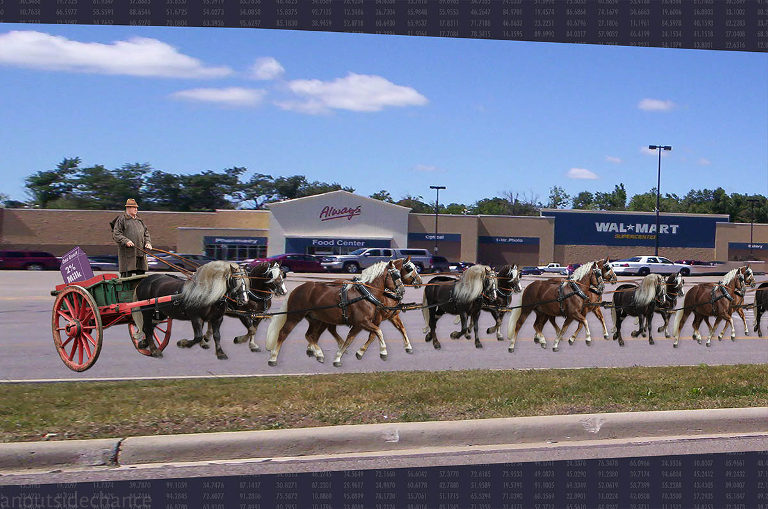When was the last time one of your relatives bought so many victuals they needed a team of a hundred horses to haul the load back from the market?
Perhaps it was that time your great uncle Napoleon was preparing for his not-so-great trip to Moscow.
Or perhaps your great great great uncle Christopher needed a long team of horses to move his groceries before he got in a boat to try to sail to India. Or your extra-extra-great grandpa Richard I, who really bought in bulk before his trip to the Holy Land in 1191.
More likely, though, if you live in North America, somebody from your family needed a team of hundreds of horses to bring home groceries in the past 24 hours – even if they were only picking up a carton of milk or a bag of cheese puffs.
“Need” might not be exactly the right word – but they used a team of hundreds of horses nonetheless, in the sense that they fired up the same hundreds-of-horsepower engine that they use for nearly every local trip no matter how light the cargo.
This grotesque mismatch between the task at hand and the tools we use for that task, have played a large role in pushing us deep into a climate crisis. At the same time, this mismatch can point us to one of the easiest, least painful ways we can move toward true sustainability.
When we look at our dominant car culture, we can consider it from a system standpoint or a device standpoint. On a system level, we have constructed a society in which homes are far from schools, from workplaces, from stores and from entertainment. We have built wide roads and streets that facilitate, at least potentially, high speeds between these newly distant sites. We have devoted most urban public space to huge heavy vehicles that make roads and streets unsafe for pedestrians and cyclists. It took decades to build this environmental nightmare and it will take decades to fix it, even if we run out of cheap energy somewhere close to the beginning of the process.
The previous installment in this series looked at transportation on a systems level, with a call to change lifestyles so that we don’t need to, and we don’t imagine we need to, travel many thousands of kilometres every year. This post takes a narrower focus.
Strictly at the device level, some of the vehicles we use are reasonably appropriate for their typical usage, while many others are beyond absurd.
At the beginning of the 1970s, my summer job was working on a highway construction crew. As an impressionable teenager I was suitably awed when an older man, who worked as a dump-truck driver, showed me his new sports car and told me how powerful its engine was.
I don’t remember the number of horsepower it boasted, but I do remember my Dad’s reaction.
“That is really ridiculous!” my dad exclaimed. “The engine in his car is just as powerful as the engines in all of our gravel trucks!”
My dad was no opponent of car culture – he had a successful career building highways throughout half a dozen US states. But after growing up on a Minnesota farm, driving tractors and grain trucks since before he was ten years old, he had an instinctive understanding of the capabilities and usefulness of different engines.
He understood that for steady work hauling 10 or 15 ton loads, often along hilly highways at speeds up to the speed limit, a 300-hp engine was appropriate. But for hauling one young man along roads with the same speed limits, a 300-hp engine was ludicrous.
As it was in the 1970s, so it is today. Some of the devices we use for transportation – those used to haul heavy freight – have a reasonably powered engine for their assigned task. It will be a difficult challenge to convert their engines from fossil fuels. (Simply moving a lot less freight in the first place is one answer, of course, but that’s a system-level topic beyond the scope of this essay.)
But a greater number of the vehicles on our roads have power systems vastly beyond those needed, even if we accept for the moment that the “need” is to carry a person tens of thousands of kilometres along roads every year, sometimes at speeds of roughly 100 km/hr. There would be no technical hurdles in accomplishing that same task with power systems using a small fraction of the energy. The challenge would be cultural, not technical.
Going nowhere fast. Newly manufactured light trucks awaiting distribution and sale, parked outside GM Canada building in Oshawa, Ontario, Aug 28 2022.
“Get just enough horsepower to do the job.”
That 1970s truck driver whose muscle car impressed the teenage me and perplexed my practical dad? It turns out that by driving a car with the power of a dump truck, he was an avatar of the American future. Today, it is commonplace for Americans to make their daily rounds in cars with the power of dump trucks.
And how much power is that? In 2010, Brian Lindgren, a marketing director for Kenworth Trucks, offered prospective truck buyers this advice:
“One of the big mistakes many people make with dump truck engines is they spec too much power, says Lindgren. ‘You should get just enough horsepower to do the job. Generally, 350 to 400 horsepower is plenty for most applications. Extra horsepower just uses more fuel, puts more strain on the rest of the drivetrain, and adds cost up front.’”1
Other trucking-industry publications make similar points: an appropriate horsepower range is somewhere between 300 and 600 horsepower, with the high numbers corresponding to semi-trailer tractors and “Super Dump” trucks carrying highway-legal payloads up to 26 tons.2, 3
This is the kind of advice that makes sense to practical business people who want to earn a profit from their vehicle. For that purpose, there’s no point in forking out a lot of extra cash upfront, and extra cash at every fuel re-fill, for an engine with horsepower far in excess of what’s needed.
Those practical considerations don’t count for much with the typical North American car buyer. The typical cargo is small – just one, and occasionally two or three, warm bodies weighing from 150 – 300 pounds each. But apparently the weight of desire for status, and the weight of drivers’ insecurity, has been on a decades-long climb – at least if we go by the size and horsepower rating of the vehicles they choose to move around in.
This chart by Kevin Drum illustrates the trend:
By Kevin Drum, from his article “Raw Data: Horsepower of New Vehicles in the US”, on Jabberwocking.
As recently as 1980, when most buyers of pick-up trucks had a day-to-day practical need for such a vehicle, engines were only slightly more powerful than the engines in typical cars. Today pick-up truck horsepower ratings have nearly tripled, while engines in cars have more than doubled.
What that graph doesn’t show is that pick-up trucks have become a far larger share of the automotive market in recent years, as if an epidemic of cattle-ranching or lumberjacking has taken hold in every North American suburb.
A question arises: are today’s four-door pick-up trucks merely oversize cars in disguise, or are today’s oversize SUVs actually trucks in disguise?
Whatever. The US Department of Energy lumps them together with other cars as “light-duty” vehicles, and finds that in this category:
“Preliminary data for model year 2021 show that the average horsepower (hp) reached 252, an increase of more than 6 hp over the 2020 model year.”4
If the average new personal passenger vehicle has a 252 horsepower engine, then something like half of those vehicles have a good bit more power – right up into the dump-truck or semi-trailer tractor range.
Car & Driver reported in 2021 that “Finding an SUV with about 400 horsepower is relatively easy these days. That number just doesn’t impress like it once did.”
These days if your personal vehicle has only as much power as an ordinary dump truck, you’re not making much of a statement. But don’t worry – if you’ve got the cash or the credit, you can buy a vehicle with as much or more power as a big, big, big dump truck. Car & Driver lists 15 SUVs and crossover vehicles with power ratings from just under 600 hp to more than 700 hp.5
Costs, benefits, and opportunities
What’s the problem, defenders of superpowered cars might ask? After all, just looking at horsepower is an oversimplification that might give the wrong impression. The horsepower rating of passenger vehicles nearly doubled in the period 1989 to 2019, and vehicle weight increased by 24%, but it’s not as if fuel economy has taken a big hit. In fact, average fuel economy improved modestly.
And one ultra-important measure of performance improved dramatically in spite of the extra weight: “acceleration increased (i.e., 0-60 mph times dropped) by 37%.”6 Car & Driver notes that the most powerful SUV on its list “can get to 60 mph in just 3.6 seconds.”7
Just think of all the time that saves a rushed commuter! Between the time a driver leaves a red light and catches up to the snarl of traffic behind the next light, he might save two or three seconds. Between the time he turns onto a freeway on-ramp and the time he reaches the maximum speed that won’t risk an expensive speeding ticket, he might save several seconds, compared to driving with the woefully underpowered vehicles of the 1970s or 1980s. In a long commute with many starts and stops, those precious seconds saved through superior acceleration could add up to a minute or more.
And it’s not as if that massive engine is working hard and really sucking down fuel all the time. Once the vehicle is at cruising speed, power usage is way down and fuel usage is (relatively) lower too.
All true. And yet …. Manufacturing cars that weigh a lot more, and manufacturing millions of bigger engines to propel those heavier vehicles, also has a correspondingly larger carbon footprint. All cars – be they subcompacts or supersize SUVs, gas, diesel, or electric – have resulted in a lot of carbon emissions before the impatient driver even revs the engine for the first time. The more materials used to make that vehicle, the bigger the upfront carbon emissions.
If or when we switch to electric vehicles, those issues of weight and power don’t magically go away. The larger and heavier a vehicle is, the larger the battery needs to be. The larger the batteries, the more scarce minerals we need to mine and refine, and the more high-speed chargers we’ll need to get these big batteries recharged in a reasonable length of time.
We’re in a period when we have a desperate need to curtail fossil fuel combustion, but during which we have only a small fraction of the clean renewable energy installations that would be needed to power an industrial society like ours. It would be folly to continue building bulky, heavy, massively overpowered vehicles to move one or two passengers along roads, and therefore devoting a huge share of our still scarce clean power supplies to building and/or operating that oversized vehicle fleet.
On a system level this is a long-term and complicated problem; we need to dramatically reduce the need to travel far and fast just to get to work or school on a daily basis. But on a device level it is simple. We could build cars that carry one or two people8 , and occasionally the smaller families that are typical today, plus a typical haul of groceries, at speeds up to but not a lot faster than highway speed limits. We could employ the latest automotive engineering improvements, not to move ever heavier vehicles ever faster, but to power lighter vehicles with the best energy efficiency currently achievable.
As we try to “electrify everything”, with clean renewable energy installations that are still nowhere near adequate for the transition, we should ensure that cars and “light trucks” make the smallest possible demands on our electricity network.
Technically that’s easy but culturally it’s hard. We have an auto industry, after all, whose key to bigger profits has been to persuade people their cars are never big enough or powerful enough. And we have millions of traffic-bound motorists convinced that it really matters whether their cars can go from 0 – 60 in 10 seconds or 5 seconds.
• • •
In the next installment in this series, we’ll look at a combined system-and-device level problem. In the cities where most people live, a big share of vehicle trips don’t actually require use of a car or a truck. How can we change the mode share of urban trips quickly, using existing technologies, and what kind of devices are most appropriate?
Illustration at top of post: detail from Market Economy, composed by author from Creative Commons-licensed images – Horses from image at pxhere.com; wagon and driver from photo by Milo Bost0ck, from Wikimedia Commons; Wal-Mart Supercentre, N Lexington-Springmill Rd, Ontario, OH, photo by Kirk Allen, from Wikimedia Commons; milk carton illustration by Paul Robinson, from Wikimedia Commons; random number background created in Excel.
References
1 Source: constructionequipment.com.
2 “How much horsepower does a semi-truck have?” on Trucker’s Corner, August 6, 2019.
3 “Dump Trucks 101: how to choose the right one”, on customtruck.com
4 US Office of Energy Efficiency and Renewable Energy Fact of the Week, Feb 7, 2022.
5 Car & Driver, “Most Powerful Crossovers and SUVs on Sale Today,” Nov 13, 2021.
6 Personal Transportation Factsheet, University of Michigan.
7 Car & Driver, Nov 13, 2021.
8 “In 1977, the U.S. average vehicle occupancy was 1.87 persons per vehicle. In 2018, average car occupancy was 1.5 persons per vehicle.” – Personal Transportation Factsheet, University of Michigan.








